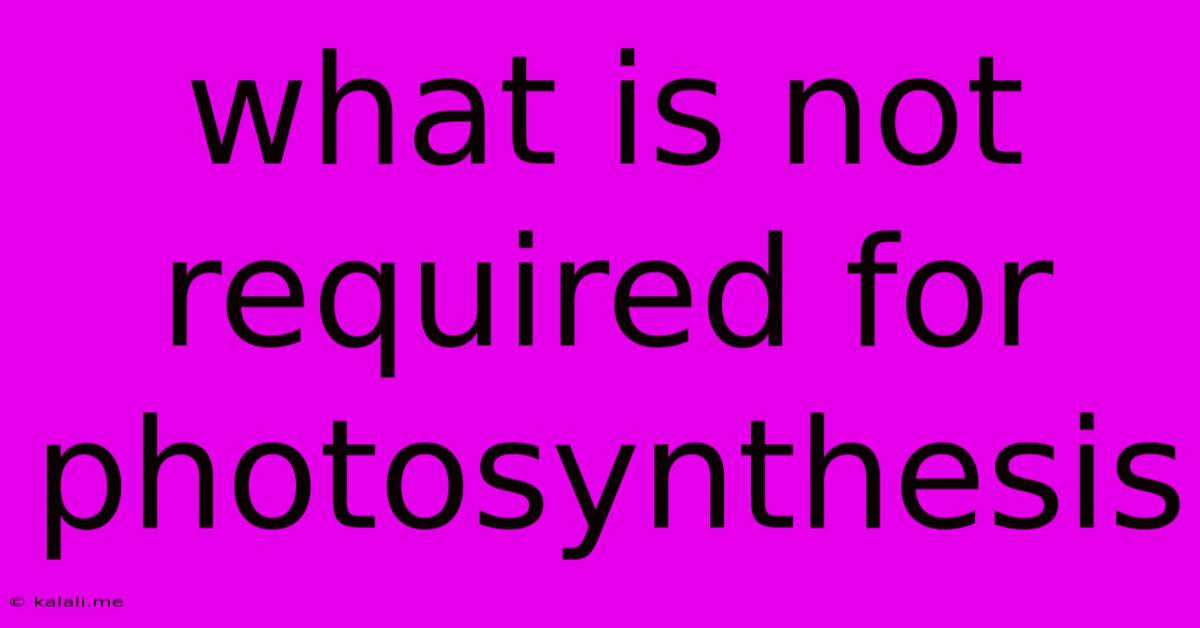What Is Not Required For Photosynthesis
Kalali
Jun 14, 2025 · 3 min read

Table of Contents
What Isn't Required for Photosynthesis: Dispelling Common Myths
Photosynthesis, the remarkable process by which plants and other organisms convert light energy into chemical energy, is often simplified in textbooks. While we learn about the key ingredients – sunlight, water, and carbon dioxide – understanding what's not required is equally important for a complete picture. This article will delve into the factors that are unnecessary for this vital process, dispelling some common misconceptions.
Understanding the Core Process: Before we explore what's unnecessary, let's briefly recap the essentials. Photosynthesis uses sunlight as the energy source, water as an electron donor, and carbon dioxide as the carbon source to produce glucose (a sugar) and oxygen. This occurs primarily in chloroplasts, the specialized organelles within plant cells containing chlorophyll, the crucial pigment responsible for capturing light energy.
Factors Not Required for Photosynthesis:
-
Oxygen: A common misconception is that oxygen is required for photosynthesis. In reality, oxygen is a byproduct of photosynthesis, released as a result of the splitting of water molecules during the light-dependent reactions. The process itself doesn't require oxygen; in fact, some photosynthetic organisms thrive in anaerobic (oxygen-free) environments.
-
Nutrients (beyond water and carbon dioxide): While plants require various nutrients like nitrogen, phosphorus, and potassium for overall growth and health, these are not directly involved in the photosynthetic process itself. These nutrients contribute to the plant's overall structure and function, supporting the production of enzymes and other components crucial for various cellular processes, but aren't required for the fundamental chemical reactions of photosynthesis. Their deficiency will negatively impact the plant's ability to photosynthesize efficiently but their presence isn't directly needed in the reaction itself.
-
High Temperatures: While photosynthesis works best within a specific temperature range (optimum varies depending on the plant species), it doesn't require high temperatures. Extreme heat can damage the photosynthetic machinery, leading to reduced efficiency or even plant death. Many plants thrive in cooler environments, demonstrating that high temperatures are not essential for the process.
-
Soil: Again, this is a common misunderstanding. While soil provides essential nutrients and anchors the plant, the photosynthetic process itself occurs within the plant's cells, independent of the soil's presence. Plants can photosynthesize successfully in hydroponic systems, which don't utilize soil at all.
-
Visible Light (entire spectrum): While visible light is the primary energy source, photosynthesis doesn't require all wavelengths of visible light equally. Chlorophyll absorbs most strongly in the blue and red portions of the spectrum, meaning green light is reflected (hence the green color of most plants). Photosynthesis can still occur with a limited range of visible light wavelengths, although efficiency might be lower than under full sunlight.
-
Wind: Wind plays a role in plant growth and development by facilitating gas exchange and pollination. However, it's not a requirement for the photosynthetic process itself. Plants can photosynthesize effectively in still air, though adequate carbon dioxide supply is still crucial.
Conclusion:
Understanding the factors not essential for photosynthesis clarifies the core process. While numerous external factors influence the rate and efficiency of photosynthesis, only sunlight, water, and carbon dioxide are directly involved in the fundamental chemical reactions that convert light energy into chemical energy. The other factors are important for the overall health and growth of the plant but are not directly part of the photosynthetic mechanism. This knowledge allows for a deeper appreciation of the resilience and adaptability of this vital process.
Latest Posts
Latest Posts
-
What Is The Measure Of Angle 6
Jun 15, 2025
-
The Mass Per Unit Volume Of A Substance Is Called
Jun 15, 2025
-
What Is The Opposite Of Dangerous
Jun 15, 2025
-
Which Of The Following Is A Mechanical Wave
Jun 15, 2025
-
Is Dcm More Dense Than Water
Jun 15, 2025
Related Post
Thank you for visiting our website which covers about What Is Not Required For Photosynthesis . We hope the information provided has been useful to you. Feel free to contact us if you have any questions or need further assistance. See you next time and don't miss to bookmark.